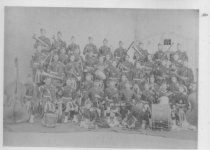Hurrah for the Welsh! We love our bands - look you!
Surprisingly early for the use of skins by the East Lancs.
I will certainly file away those two little gems of information for possible future use. I think that I already have a tenor drummer in an existing SWB band. I bought it off the shelf (castings version) from Sarum - before he gave up the trade! In those days, I took things a bit more for granted than I do now!
Many thanks for your encyclopedic knowledge, archive material, and friendship trooper. All of your help is very much appreciated. I think that all I have to do now - is get cracking on finishing off quite a few projects - in order that I progress this one. Snag is, I have already "bumped into" yet another thought, based on what I have read in this search for information.
As mentioned before, Giles has confirmed now, that he will have just about all of the bits needed by Springtime - so all seems set to go then. We have a small bit of work to do on weaponary - but that's about it - I think. I will maybe try to finalise just what instruments I want in the band. Your photos have helped considerably here - as they appear to be quite heavy on brass especially at the deeper end of the spectrum! There appear to be a lot of euphoniums and tubas around. I think that I will be a bit more adventurous in this area though. As you rightly say, the Bandmaster had considerable lattitude in his choice of instrument for the band. To all intents then - I am "the bandmaster" for this project!
I am currently THINKING about squeezing in the Bell Lyre and Sax, though NOT because I have found photos to PROVE they were there in 1871 - but KNOW they COULD have been. The tenor drum question, however, was a bit different. I couldn't say - hand on heart - that they COULD have been - and, it appears, nobody else can either! As I told someone the other day - IF I just put one in, then I may as well make a medieval band, and put someone in playing a harmonica!
Now that I know that the first known use of tenor drums in the British Army was in the RA around 1835 - this has kicked off yet another idea!! Simkins shows a gorgeously attired Drum Major in his "Blue Book ,(Carman, 1985, plate 106b, p.190). I would love to have one. He's shown in 1840, so said drummer would fit in...... look out...... I'm off again! Please don't investigate yet though - as this is a very early "ideas stage" project - and I have enough to get on with now! This one MAY be a future one. Interesting period in history this - eh?
Thanks for all of your help, encouragement and advice so far my friend. This is very much appreciated. regards, johnnybach
PS found this whilst reading last night - seems appropriate, as an early use of the drum as a warning instrument.
"Take my drum to England
Hang it by the shore,
Strike it when your powder's running low.
If the Dons sight Devon, I'll quit the port o'heaven,
And drum them up the channel as we drummed them long ago"
by Sir Henry Newbolt - referring to Drake's Drum.
Wonder if it was a tenor? - Stirs the blood a bit - don't you think?







